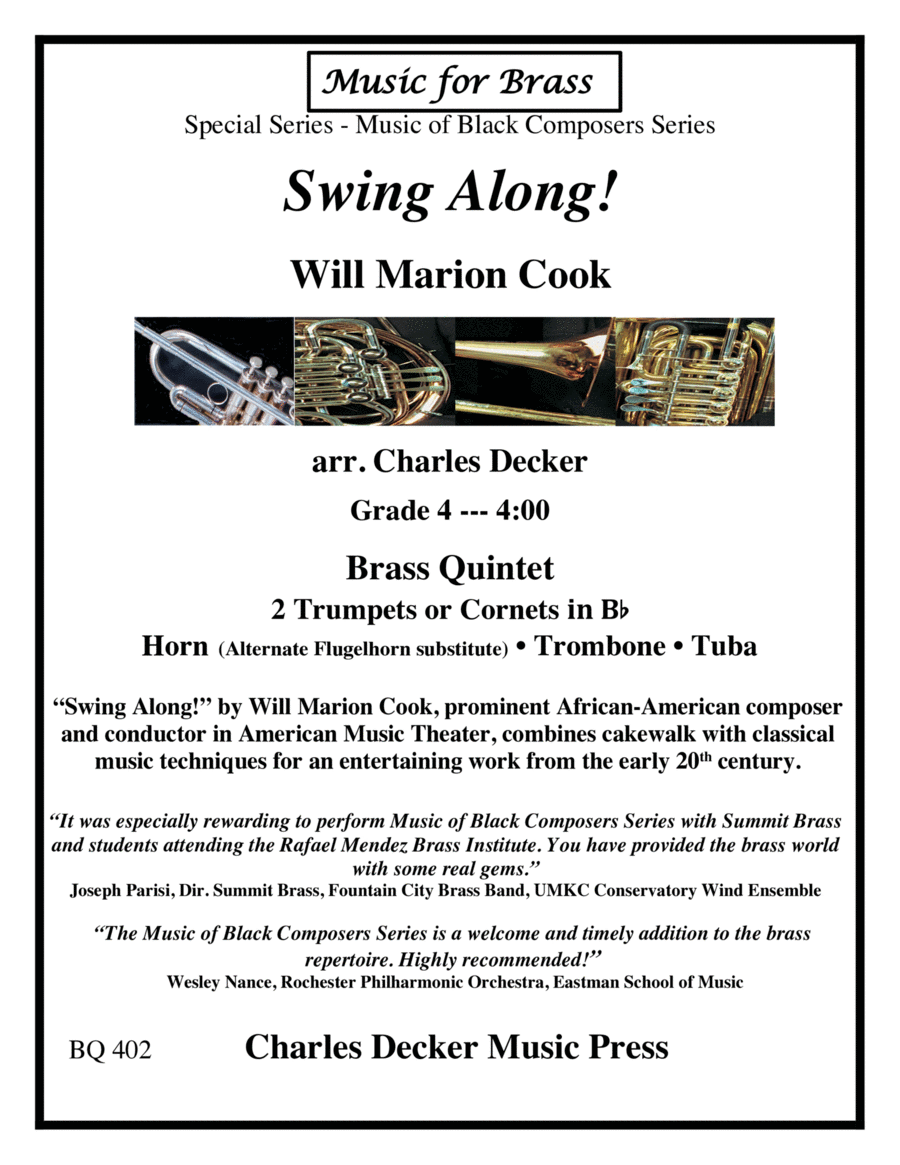Brass Quintet Cornet,Euphonium,Flugelhorn,Trombone,Trumpet,Tuba - Level 3 - Digital Download SKU: A0.1145313 Composed by Will Marion Cook. Arranged by Charles Decker. 20th Century,Broadway,Jazz,Multicultural,Musical/Show,Pop,World. 20 pages. Charles Decker Music Press #745558. Published by Charles Decker Music Press (A0.1145313). Swing Along! by Will Marion Cook, prominent African-American in Music Theater, composer, conductor, and violinist, combines Cakewalk style with classical music techniques to create an entertaining and memorable work from the early 20th century now arranged for a brass quintet of two trumpets or cornets in B-flat, horn in F (alternate flugelhorn part provided), trombone and tuba. The recording is of the complete edition. Cook was a key figure in American music from the 1890s to the 1920s. His Swing Along! was written for a theater production in 1903 combining Black folk music with classical music techniques and became a popular standard with choruses and glee clubs. A violin virtuoso, he studied at Oberlin College, Berlin's Hochschule für Musik with Joseph Joachim, and New York's National Conservatory of Music with Antonin Dvorak. He devoted his career to Black musical comedies and was instrumental in showcasing his Southern Syncopated Orchestrat throughout the Unites States and Europe, featuring New Orleans clarinetist Sidney Bechet. Mentored by Frederick Douglas, Will Marion Cook went on to mentor Duke Ellington, paving the path for orchestral concert jazz. âThe Music of Black Composers Series is a welcome and timely addition to the brass repertoire. Interesting music, expertly arranged, fun to perform, and well received by audiences. Highly recommended!â  Wesley Nance, Rochester Philharmonic Orchestra, Eastman School of MusicâI was so pleased to see the great works arranged for brass ensemble by Charles Decker Music Press especially the Music of Black Composersâ Series. It was especially rewarding to perform several of these with Summit Brass and with the students attending the Rafael Mendez Brass institute. Please keep these wonderful settings coming. You have provided the brass world with some real gems.â  Joseph Parisi, Director Summit Brass, Fountain City Brass Band, University of Missouri Kansas City Conservatory Wind EnsembleThe Interlochen Arts Academy and the University of Denver have purchased the Music of Black Composer Series with Charles Decker Music Press and the summer Rafael Mendez Brass Institute and Eastman School of Music uses the series arrangements in their chamber and brass ensembles music programs. See 50+ homogeneous brass editions for trumpet, horn and trombone ensembles and 75+ mixed brass ensemble publications with Charles Decker Music Press at Sheet Music Plus for inexperienced to advanced musicians with music ranging from the Renaissance to contemporary new works for trios, quartets, quintets, brass choir and brass band. Many of the mixed brass ensemble editions include alternate and substitute parts being alternate C trumpet parts for B-flat trumpet parts, flugelhorn/trumpet substitute for horn, horn substitute for trombone and treble clef euphonium substitute for trombone. To see our Music of Black Composers Series enter âBlack Composers Seriesâ in the search box at Charles Decker Music Press for 25 arrangements for mixed brass ensembles ranging from early jazz to symphonic works with composers Samuel Coleridge-Taylor, R. Nathaniel Dett, William Grant Still, Will Marion Cook, James Reese Europe, James Johnson and others.
